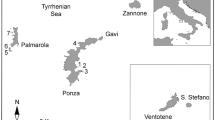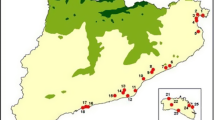Abstract
Records of Hipparchia semele on British and Irish islands have been modelled against island area, isolation (sea and land distance) and the size of the nearest potential source populations. All three variables have been found to contribute significantly to the presence or absence of H. semele on the islands. Isolation is a more significant predictor than island area. This result differs from the multiple species case where area was found to be a more important influence than isolation. Records on islands are also shown to depend on the size of populations at the nearest sources; this underpins the relationships identified for the multiple species case, first, between the number of species on islands and at nearest sources and, second, between the incidence of species on islands and at nearest sources. There are clear indications that smaller islands may become increasingly marginalized for H.␣semele; with ongoing habitat loss, because isolation increases and source populations become sparser, the probability of H. semele recolonizing islands also decreases.
Similar content being viewed by others
References
Dennis, R.L.H. (1997) A record of Hipparchia semele (L.) (Lep.: Satyrinae) for Grassholm Island, Wales. Entomol. Rec. J. Var. 109, 88.
Dennis, R.L.H. and Shreeve, T. G. (1996) Butterflies on British and Irish Offshore Islands. Wallingford, Oxfordshire: Gem Publishing Company.
Dennis, R.L.H. and Shreeve, T.G. (1997) Diversity of butterflies on British islands: ecological influences underlying the roles of area, isolation and the size of the faunal source. Biol. J. Linn. Soc. 60, 257–75.
Emmet, A.M. and Heath, J. (1990) The Butterflies of Great Britain and Ireland. Colchester: Harley Books.
Hanski, I. and Gilpin, M. (1997) Metapopulation Biology: Ecology, Genetics and Evolution. London: Academic Press.
Harrison, S., Murphy, D.D. and Ehrlich, P.R. (1988) Distribution of the bay checkerspot butterfly, Euphydryas editha bayensis: evidence for a metapopulation model. Am. Nat. 132, 360–82.
Nieminen, M. (1996) Migration of moth species in a network of small islands. Oecologia 108, 643–51.
Shreeve, T.G., Dennis, R.L.H. and Pullin, A.S. (1996) Marginality: scale determined processes and the conservation of the British butterfly fauna. Biodiv. Conserv. 5, 1131–41.
STATISTICA (1994) Statistics for Windows 1-3. Tulsa, OK: Statsoft, Inc.
Thomas, C.D. and Abery, J.C.G. (1995) Estimating rates of butterfly decline from distribution maps: the effect of scale. Biol. Conserv. 73, 59–65.
Thomas, C.D. and Hanski, I. (1997) Butterfly metapopulations. In Metapopulation Biology (I. Hanski and M. Gilpin, eds) pp. 359–86. London: Academic Press.
Thomas, C.D., Thomas, J.A. and Warren, M.S. (1992) Distributions of occupied and vacant butterfly abitats in fragmented landscapes. Oecologia 92, 563–7.
Author information
Authors and Affiliations
Rights and permissions
About this article
Cite this article
Dennis, R.L.H., Shreeve, T.G. & Sparks, T.H. The effects of island area, isolation and source population size on the presence of the grayling butterfly Hipparchia semele (L.) (Lepidoptera: Satyrinae) on British and Irish offshore islands. Biodiversity and Conservation 7, 765–776 (1998). https://doi.org/10.1023/A:1008840403101
Issue Date:
DOI: https://doi.org/10.1023/A:1008840403101




